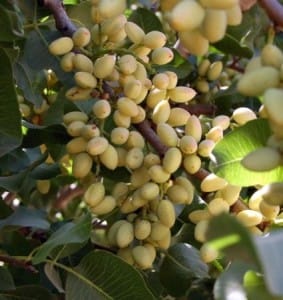This Action Alert is Over.
GMO Apples?
The USDA’sAnimal and Plant Health Inspection Service is poised to approve a genetically engineered apple, called the Arctic Apple®. The public comment period runs through Monday, December 16. Click here to read Cornucopia’s submitted comments.
You can comment directly here:
http://www.regulations.gov/#!submitComment;D=APHIS-2012-0025-1938
 Okanagan Specialty Fruits has developed a GMO Golden and Granny Smith apple that is designed not to brown when sliced and exposed to the air. Browning reflects an apple’s freshness – something all consumers are interested in.
Okanagan Specialty Fruits has developed a GMO Golden and Granny Smith apple that is designed not to brown when sliced and exposed to the air. Browning reflects an apple’s freshness – something all consumers are interested in.
The actual genetic engineering process includes insertion of nptII, neomycin phosphotransferase type II gene from E. coli Tn5. This gene allows the transformed apple tissue to grow on a medium containing the antibiotic kanamycin but confers no benefit to the apple plant.
Every cell of every GE apple tree, including the fruit and the tree roots, will show resistance to kanamycin. Kanamycin is a commonly used antibiotic in human medicine, used to treat a wide variety of infections.
- Eating an Arctic Apple could transfer the gene for kanamycin resistance into your digestive system. A similar transfer has been demonstrated with GE soy. There is a real possibility that bacteria in the human digestive systems could develop kanamycin resistance. Antibiotic resistance is a major concern among medical professionals.
- Furthermore, the GE apple’s DNA can also spread to bacteria on the plant and in the soil. Orchardists might very well find that controlling diseases of special concern like fireblight in orchards may become much more difficult. And in the soil environment, the GE DNA can persist for at least a year, where it can be taken up by natural soil bacteria and then incorporated into their genetic structure.
There is no proof that Arctic Apples are harmless, but there is certainly reason to suspect that they may be harmful to humans, wildlife, and the soil environment. Urge the USDA to reject approval of the Arctic Apple. The unknown risks far outweigh the cosmetic value of an apple that doesn’t brown when sliced.
For additional information, click on the links to read the USDA’s Animal and Plant Health Inspection ServiceEnvironmental Assessment (EA) and Plant Pest Risk Assessment (PPRA) for the GE Arctic apples.
Crushed Nuts
 The FDA is gathering information concerning the
The FDA is gathering information concerning the Salmonella risk associated with the eating of “tree nuts.” According to the FDA notice (no longer available at this link):
“… outbreaks, published reports of Salmonella in tree nuts destined for human consumption, and recalls emphasize the need to assess the risk of salmonellosis associated with tree nuts intended for human consumption, and to evaluate the appropriate risk-based preventive controls needed to reduce the risk of human salmonellosis….”
The FDA says that almonds, desiccated coconut and pine nuts have been associated with Salmonella outbreaks. And they point to cashews, Brazil nuts, macadamias, pistachios, shelled hazelnuts and walnuts as other nuts associated with Salmonella.
The FDA is accepting public comments on the risk and its evaluation through Monday, December 16. You can comment electronically at:
http://www.regulations.gov/#!submitComment;D=FDA-2013-N-0747-0010
When the USDA mandated a post-harvest treatment for California raw almonds in 2007, the impact was severe for many raw nut growers and distributors. They were required to treat their nuts with a toxic fumigant (propylene oxide) or steam heat the nuts before they could be sold as “raw” to American consumers. Imports were not subject to this mandate nor were domestic producers outside of California.
 Many producers lost sales (at least one reporting millions of dollars lost) to untreated imports as consumers rebelled against the controversial treatment of a nutritious raw product for a variety of reasons, including a reported change (by some) in the texture, the nutritive value of the treated nut, and potential use of a toxic gas on their food.
Many producers lost sales (at least one reporting millions of dollars lost) to untreated imports as consumers rebelled against the controversial treatment of a nutritious raw product for a variety of reasons, including a reported change (by some) in the texture, the nutritive value of the treated nut, and potential use of a toxic gas on their food.
The USDA almond mandate slipped through almost unnoticed, although it created a rather large uproar following its implementation. This information gathering effort by the FDA could very well be the first step towards mandating a similar treatment scheme, or even one including irradiation, for all consumable raw nuts.
If you prefer, you may mail written comments, postmarked by December 16, to:
Division of Dockets
Management (HFA–305)
Food and Drug Administration
5630 Fishers Lane, Rm. 1061
Rockville, MD 20852.
Make sure you reference Docket No. FDA–2013–N–0747 with any comments sent by mail.
What the FDA seems willing to ignore, in its zest to squelch potential contamination of foods by infectious human pathogens like salmonella, are the primary sources of many of the fecal associated pathogens found on food. The massive amounts of manure stored at the nation’s industrial-scale livestock facilities are such source. The escape of the highly infectious pathogens via air-blown dust, water, and run-off that contaminates neighboring lands and our rural countryside. Responsibility for control of these disease causing pathogens should be undertaken at the source.
The FDA has also been unwilling to look at issues of scale. In the case of mandatory almond pasteurization the only trace-back of a salmonella outbreak implicated Paramount Farms, the nation’s largest almond and pistachio producer. In order to bring massive operations into compliance regulators are willing to promulgate “one-size-fits-all” rulemaking that create onerous requirements and costs damaging family-scale producers.

